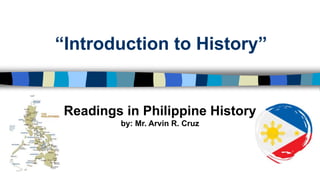The Colonial Philippines - Spanish Occupation History.pptx
•Download as PPTX, PDF•
0 likes•2 views
HISTORY
Report
Share
Report
Share

Recommended
Recommended
More Related Content
Similar to The Colonial Philippines - Spanish Occupation History.pptx
Similar to The Colonial Philippines - Spanish Occupation History.pptx (20)
RPH-Lesson-1.pdfreadings in the philippine history

RPH-Lesson-1.pdfreadings in the philippine history
Module-1_Readings-in-Philippine-History_Students-Copy.pptx

Module-1_Readings-in-Philippine-History_Students-Copy.pptx
Readings in Philippine history for 1st year college

Readings in Philippine history for 1st year college
Week-1-n-2_Lessons-1-and-2-in-Readings-in (1).pptx

Week-1-n-2_Lessons-1-and-2-in-Readings-in (1).pptx
More from ArvinCruz19
More from ArvinCruz19 (10)
Recently uploaded
https://app.box.com/s/7hlvjxjalkrik7fb082xx3jk7xd7liz3TỔNG ÔN TẬP THI VÀO LỚP 10 MÔN TIẾNG ANH NĂM HỌC 2023 - 2024 CÓ ĐÁP ÁN (NGỮ Â...

TỔNG ÔN TẬP THI VÀO LỚP 10 MÔN TIẾNG ANH NĂM HỌC 2023 - 2024 CÓ ĐÁP ÁN (NGỮ Â...Nguyen Thanh Tu Collection
Recently uploaded (20)
Salient Features of India constitution especially power and functions

Salient Features of India constitution especially power and functions
Vishram Singh - Textbook of Anatomy Upper Limb and Thorax.. Volume 1 (1).pdf

Vishram Singh - Textbook of Anatomy Upper Limb and Thorax.. Volume 1 (1).pdf
TỔNG ÔN TẬP THI VÀO LỚP 10 MÔN TIẾNG ANH NĂM HỌC 2023 - 2024 CÓ ĐÁP ÁN (NGỮ Â...

TỔNG ÔN TẬP THI VÀO LỚP 10 MÔN TIẾNG ANH NĂM HỌC 2023 - 2024 CÓ ĐÁP ÁN (NGỮ Â...
On National Teacher Day, meet the 2024-25 Kenan Fellows

On National Teacher Day, meet the 2024-25 Kenan Fellows
HMCS Max Bernays Pre-Deployment Brief (May 2024).pptx

HMCS Max Bernays Pre-Deployment Brief (May 2024).pptx
Unit-V; Pricing (Pharma Marketing Management).pptx

Unit-V; Pricing (Pharma Marketing Management).pptx
Basic Civil Engineering first year Notes- Chapter 4 Building.pptx

Basic Civil Engineering first year Notes- Chapter 4 Building.pptx
UGC NET Paper 1 Mathematical Reasoning & Aptitude.pdf

UGC NET Paper 1 Mathematical Reasoning & Aptitude.pdf
Kodo Millet PPT made by Ghanshyam bairwa college of Agriculture kumher bhara...

Kodo Millet PPT made by Ghanshyam bairwa college of Agriculture kumher bhara...
The Colonial Philippines - Spanish Occupation History.pptx
- 1. “Introduction to History” Readings in Philippine History by: Mr. Arvin R. Cruz
- 2. What is the first word that comes to your mind whenever you hear the word HISTORY?
- 5. FACT OR BLUFF “History Repeats Itself”
- 6. DEFINITION OF HISTORY History comes from the Greek word historias which means “the art of story telling” It is the systematic written account/record of past events.
- 7. HERODOTUS (484 – 425 BCE) Greek Historian known as the “Father of History” and also the “Father of Geography” “The First Historian in the World” The author of “The Histories” - a book about the history of Persian Empire
- 8. He said that History is a systematic and scientific process of study that give us the knowledge by means of inquiry of human past and present events.
- 9. CONTEMPORARY HISTORY History is the totality of human past and present experienced. Also refers to the past events of a period or in the life or development of a people, an institution, or a place. It also means "inquiry, knowledge acquired by investigation" is the discovery, collection, organization, and presentation of information about past events.
- 10. SOURCES IN STUDYING HISTORY Primary Source (Pangunahing Batis-Pangkasaysayan) The primary source provides direct or firsthand evidence about an event, object, person, or work of art. Primary sources include historical and legal documents, eyewitness accounts, results of experiments, statistical data, pieces of creative writing, audio and video recordings, speeches, and art objects. Interviews, surveys, fieldwork, and internet communications via email, blogs, listservs, and newsgroups are also primary sources.
- 11. Secondary Source (Pangalawang Batis-Pangkasaysayan) The secondary sources describe, discuss, interpret, comment upon, analyze, evaluate, summarize, and process primary sources. Secondary source materials can be articles in newspapers or popular magazines, book or movie reviews, or articles found in scholarly journals that discuss or evaluate someone else's original research.
- 12. EXTERNAL & INTERNAL CRITICISM External Criticism It refers to the genuineness of the documents a researcher uses in a historical study. Examples of the things that will be examined when conducting external criticism of a document include the quality of the paper, the type of ink, and the language and words used in the material, among others.
- 13. EXTERNAL & INTERNAL CRITICISM Internal Criticism It refers to the accuracy of the contents of a document. It looks at the content of the source and examines the circumstance of its production. Internal criticism looks at the truthfulness and factuality of the evidence by looking at the author of the source, its context, the agenda behind its creation, the knowledge which informed it, and its intended purpose, among others.
- 14. IMPORTANCE OF STUDYING HISTORY To understand the past; To understand the present; and To prepare for the future
- 17. FACT OR BLUFF “History Repeats Itself”
- 19. “History does not repeat itself; it is just because man commits the same mistake.” -Anonymous
- 21. -The End-